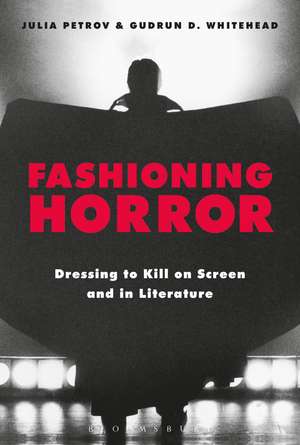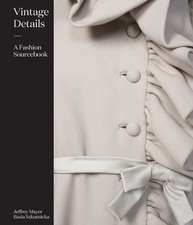Fashioning Horror: Dressing to Kill on Screen and in Literature
Editat de Julia Petrov, Gudrun D. Whiteheaden Limba Engleză Paperback – 21 aug 2019
Preț: 231.06 lei
Preț vechi: 265.20 lei
-13% Nou
Puncte Express: 347
Preț estimativ în valută:
44.22€ • 45.90$ • 36.87£
44.22€ • 45.90$ • 36.87£
Carte tipărită la comandă
Livrare economică 22 martie-05 aprilie
Preluare comenzi: 021 569.72.76
Specificații
ISBN-13: 9781350133273
ISBN-10: 1350133272
Pagini: 256
Ilustrații: 33 bw illus
Dimensiuni: 156 x 234 x 18 mm
Greutate: 0.36 kg
Editura: Bloomsbury Publishing
Colecția Bloomsbury Visual Arts
Locul publicării:London, United Kingdom
ISBN-10: 1350133272
Pagini: 256
Ilustrații: 33 bw illus
Dimensiuni: 156 x 234 x 18 mm
Greutate: 0.36 kg
Editura: Bloomsbury Publishing
Colecția Bloomsbury Visual Arts
Locul publicării:London, United Kingdom
Caracteristici
Brings together an interdisciplinary mix of scholars from around the globe, with specialisms ranging from fashion history and film studies to literature, including authors well-known to the field such as Alexandra Heller-Nicholas and Sarah Heaton
Notă biografică
Julia Petrov is Curator of Western Canadian History at the Royal Alberta Museum and Adjunct Lecturer at the University of Alberta, Canada. She is the co-editor of The Thing About Museums (2011) and Narrating Objects, Collecting Stories (2012). Gudrun D. Whitehead is an assistant professor of museum studies at the University of Iceland in Reykjavík, Iceland. She is the Icelandic editor of the journal Nordisk Museologi and the lead editor of a forthcoming special edition of Museum and Society (2018).
Cuprins
List of IllustrationsList of ContributorsIntroduction: Gudrun D. Whitehead and Julia Petrov, "Fashion and Fear"1. Sara Piccolo Paci, "'Death Dress You Anew': Fashion as Transience and Limit of Human Life in Christian Literature and Iconography between the 12th and 19th centuries"2. Stephanie Bowry: "'Their tattered mortal costumes will afford them none of the answers they seek': Clothing immortals in the work of Anne Rice, Tanith Lee and Angela Carter"3. Rafael Jaen and Robert I. Lublin: "Fashioning Frankenstein in Film: Brides of Frankenstein"4. Sarah Heaton: "Wayward Wedding Dresses: Fabricating Horror in Dressing Rituals of Femininity"5. Kasia Stempniak: "Fashioning Vengeance: Costume, Crime, and Contamination in Barbey d'Aurevilly's La Vengeance d'une Femme" 6. Alanna McKnight: "Fashions From Hell: Jack the Ripper's Enduring Influence on Dress"7. Nigel Lezama: "Slasher Consciousness: Dandyism As Killer" 8. Rafael Jaen and Robert I. Lublin: "Fashioning Frankenstein in Film: Monsters and Men"9. Nadia Buick and Alexandra Heller-Nicholas: "Horrific Transformations: Costume, Gender, and the Halloween Franchise"10. Rose Butler: "Faces of Rage: Masks, Murderers and Motives in the Canadian Slasher Film"11. Florent Christol: "Massacres and Masquerades: the Killer's Costume in the American Slasher Film and the Cultural Myth of the Foolkiller"Index
Recenzii
Fashioning Horror: Dressing to Kill on Screen and in Literature offers an incredible source to investigate the intriguingrelationship between dress and horror as narrated in literature, cinema, and television.
Fashioning Horror unlocks the chilling wardrobe of a grisly array of sartorially obsessed monsters, ghosts and killers. The essays skilfully analyse the fashionable signification of the undead, flesh-eaters, slashers and their prey; a dazzling cast of fashion victims from the twelfth century to the present day.
This book offers a worthwhile contribution to the highly apparent, but often overlooked, connection between fashion and horror. The authors in this collection pay great attention to the intricacies of fashion, costume and design across a range of horror genres. Most importantly, they explore the problems found in the link between materiality and genre itself.
Fashioning Horror unlocks the chilling wardrobe of a grisly array of sartorially obsessed monsters, ghosts and killers. The essays skilfully analyse the fashionable signification of the undead, flesh-eaters, slashers and their prey; a dazzling cast of fashion victims from the twelfth century to the present day.
This book offers a worthwhile contribution to the highly apparent, but often overlooked, connection between fashion and horror. The authors in this collection pay great attention to the intricacies of fashion, costume and design across a range of horror genres. Most importantly, they explore the problems found in the link between materiality and genre itself.







